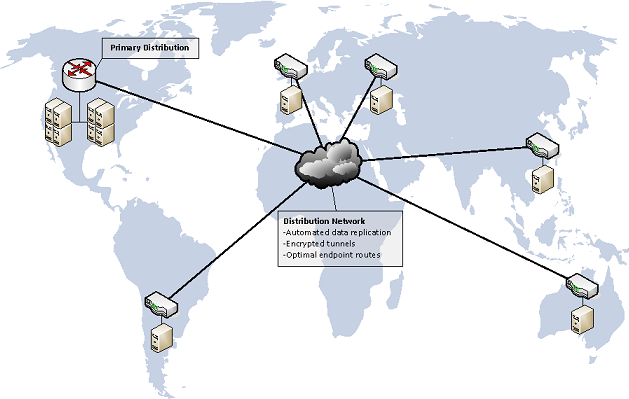
Content Delivery
Applications which target a global audience can greatly benefit from a geographically diverse content delivery network as it offers shorter delivery paths and distributed bandwidth load. We work with automation to replicate dynamic data across the delivery nodes and a separate caching layer for static content which is not expected to change as frequently. Delivery nodes within the CDN are deployed with a custom software configuration to provide accelerated data loading with little overhead. This is assisted by utilizing a caching proxy at the end-point to minimize bandwidth load, resulting in an optimal mix of dynamic to static content delivery.
- Shorter delivery paths and distributed bandwidth load
- Secure automated data replication over encrypted tunnels
- End-point caching proxy for optimizing bandwidth usage
- Eliminating single points of failure in delivery system
Network Map

- Automated data replication from primary distribution hub
- Encrypted tunnel communication between delivery nodes
- Shortest path routing from each node to end user
- Eliminates single point of failure ensuring application delivery
Bandwidth
The primary bandwidth considerations for a content delivery deployment include availability from the primary site to the end-points for data replication and availability from each end-point to the users. The deployment of CDN mirrors should factor in both current bandwidth needs and scaling to future demand. In cases of limited bandwidth availability, we can deploy external caching hosts for static content or utilize a third-party caching service to optimize content delivery. Dynamic application content requiring frequent replication to mirror hosts can benefit from the usage of dedicated carrier circuits to provide lower network latency and reduce overhead on the CDN mirror's external IP transit.
Altexxa Group's primary CDN deployment is designed for static content delivery and benefits from a third-party caching service to optimize mirror bandwidth load. We also work with flow analytics to monitor for link saturation and balance between external mirrors when needed.
- External static content caching for reduced mirror bandwidth load
- Mirror traffic balancing with flow analytics and automation systems
Implementation
Implementation of a content delivery system must take into account several considerations to determine the most effective deployment method. Requirements for ongoing replication for dynamic applications would likely include a separate dedicated replication circuit offering lower network latency. Larger mirror deployments may require end-point load balancing across node clusters and the addition of further redundant infrastructure. Implementation for dynamic applications may also require anycast network routing to effectively distribute load based on geographical metrics. Delivery of static content in areas with minimal bandwidth availability may require separate caching nodes deployed in the nearest high-peering presense to reduce risk of mirror link saturation.
- Requirement of in depth research and planning for effective implementation
- Investigating needs to determine high load zones in global audience
- Content caching at global peering points for fast static delivery
- Advanced network routing methods for dynamically driven applications
